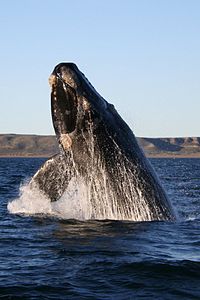
Photo from wikipedia
The relationship between group size and fitness has attracted much interest, with many attempts made to detect an optimal group size. Group size is determined by the benefits and costs… Click to show full abstract
The relationship between group size and fitness has attracted much interest, with many attempts made to detect an optimal group size. Group size is determined by the benefits and costs influencing group formation, which also influences whether groups persist or fail. We investigated whether group size is associated with success (individual survival and reproductive output) in the African ice rat Otomys sloggetti robertsi. Ice rats form mixed-sex plural-breeding colonies that trade off the benefits of huddling below-ground against within-colony resource competition above-ground. We measured behavioural correlates of individual success in summer and winter, focusing on energy saving (basking), acquisition (foraging) and use (burrow maintenance, distance travelled for foraging) behaviours. We predicted that (1) individuals in larger colonies would forage and travel more to find food because of greater within-colony competition for resources; (2) individuals in larger colonies would bask less than individuals in smaller colonies because of the greater energy savings generated from huddling in larger groups; and (3) burrow maintenance would be greater in smaller colonies because of fewer individuals engaging in this task. We showed that colonies succumbed or persisted as a group (i.e. most individuals present or all absent). In particular, in both seasons, individuals in smaller groups (≤5 individuals) were more likely to fail, while those in larger groups (≥12 individuals) were more likely to persist. The persistence of colonies was positively predicted by foraging and negatively by basking. Foraging was greater in larger colonies and burrow maintenance was greater in smaller colonies. While females of larger colonies produced more offspring in total, reproductive output (per capita offspring production) was not correlated with colony size. Individual ice rats in larger colonies accrued fitness benefits, which were predicted, proximally, by greater foraging and possibly energy savings in larger huddling groups.Statement of significanceWhat proximally determines the relationship between group size, individual success and colony persistence? In ice rats, individuals in larger groups persist, which is correlated with more foraging. Larger groups possibly enjoy the benefits of huddling in larger groups, which are re-channelled into energy-intense activities. Groups failed or persisted as a unit. Investigating the behavioural correlates of the relationship between group size and persistence provides insight into the proximal underpinnings of this relationship.
Journal Title: Behavioral Ecology and Sociobiology
Year Published: 2017
Link to full text (if available)
Share on Social Media: Sign Up to like & get
recommendations!